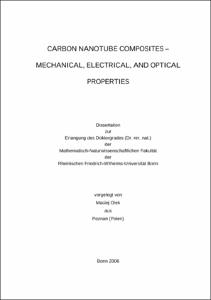Olek, Maciej: Carbon nanotube composites : mechanical, electrical, and optical properties. - Bonn, 2007. - Dissertation, Rheinische Friedrich-Wilhelms-Universität Bonn.
Online-Ausgabe in bonndoc: https://nbn-resolving.org/urn:nbn:de:hbz:5N-09494
Online-Ausgabe in bonndoc: https://nbn-resolving.org/urn:nbn:de:hbz:5N-09494
@phdthesis{handle:20.500.11811/3046,
urn: https://nbn-resolving.org/urn:nbn:de:hbz:5N-09494,
author = {{Maciej Olek}},
title = {Carbon nanotube composites : mechanical, electrical, and optical properties},
school = {Rheinische Friedrich-Wilhelms-Universität Bonn},
year = 2007,
note = {In the frame of this thesis novel concepts for the functionalization of nanotubes and fabrication of optimized, homogeneous MWNT/polymer heterostructures are presented. The effects of various dispersion states and morphologies of carbon nanotubes on mechanical, rheological, and electrical properties of the CNT-based nanocomposites were investigated. Additionally, a new approach for the fabrication of CNT/quantum-dots heterostructures for potential photoelectric and optical applications is shown. The tensile strength and elastic modulus of polymeric systems are shown to be significantly improved (even by more than 1500 %) after introducing the MWNT-filler by using the layer-by-layer assembly technique. However, nanoindentation experiments reveal that the presence of MWNTs within the polymeric host material do not have any impact on the hardness of such composites. Furthermore, shear oscillatory tests show that the viscosity of MWNT/polymer composites increases together with the concentration of the nanotubes in polymer. The rheological percolation threshold is shown to be as low as 0.5 wt% of MWNTs.
Investigations of electrical properties of MWNT/polymer heterostructures show a significant increase of electrical conductivity with the increase of the MWNTs’ content. The conductivity of the sample with only 8 wt% MWNTs load is as high as 10-2 S/cm which is four orders of magnitude higher than that of the neat polymer. The electrical percolation threshold is reached at 1.48 wt%.
Investigation of MWNT/quantum dots heterostructures reveal a complete quenching of the PL-bands, presumably through an electron transfer between QDs and MWNTs. The deposition of a silica shell (with thicknesses >20nm) around the CNTs preserves the fluorescence properties by insulating the QD from the surface of the CNT.
It is shown that carbon nanotubes as components of various nanocomposites have a significant effect on the mechanical, electrical, and optical properties of these hybrid materials. The results of this thesis indicate the potential of utilizing CNT-based nanocomposites towards mechanical, electrical, sensing, optical, and actuating applications.},
url = {https://hdl.handle.net/20.500.11811/3046}
}
urn: https://nbn-resolving.org/urn:nbn:de:hbz:5N-09494,
author = {{Maciej Olek}},
title = {Carbon nanotube composites : mechanical, electrical, and optical properties},
school = {Rheinische Friedrich-Wilhelms-Universität Bonn},
year = 2007,
note = {In the frame of this thesis novel concepts for the functionalization of nanotubes and fabrication of optimized, homogeneous MWNT/polymer heterostructures are presented. The effects of various dispersion states and morphologies of carbon nanotubes on mechanical, rheological, and electrical properties of the CNT-based nanocomposites were investigated. Additionally, a new approach for the fabrication of CNT/quantum-dots heterostructures for potential photoelectric and optical applications is shown. The tensile strength and elastic modulus of polymeric systems are shown to be significantly improved (even by more than 1500 %) after introducing the MWNT-filler by using the layer-by-layer assembly technique. However, nanoindentation experiments reveal that the presence of MWNTs within the polymeric host material do not have any impact on the hardness of such composites. Furthermore, shear oscillatory tests show that the viscosity of MWNT/polymer composites increases together with the concentration of the nanotubes in polymer. The rheological percolation threshold is shown to be as low as 0.5 wt% of MWNTs.
Investigations of electrical properties of MWNT/polymer heterostructures show a significant increase of electrical conductivity with the increase of the MWNTs’ content. The conductivity of the sample with only 8 wt% MWNTs load is as high as 10-2 S/cm which is four orders of magnitude higher than that of the neat polymer. The electrical percolation threshold is reached at 1.48 wt%.
Investigation of MWNT/quantum dots heterostructures reveal a complete quenching of the PL-bands, presumably through an electron transfer between QDs and MWNTs. The deposition of a silica shell (with thicknesses >20nm) around the CNTs preserves the fluorescence properties by insulating the QD from the surface of the CNT.
It is shown that carbon nanotubes as components of various nanocomposites have a significant effect on the mechanical, electrical, and optical properties of these hybrid materials. The results of this thesis indicate the potential of utilizing CNT-based nanocomposites towards mechanical, electrical, sensing, optical, and actuating applications.},
url = {https://hdl.handle.net/20.500.11811/3046}
}






